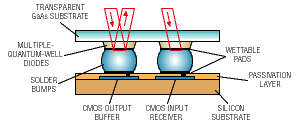Smart pixels exploit older technique
for free-space Tbit/s communication
A research program headed by Heriot-Watt University (Edinburgh, Scotland) has refined an electro-optical approach with the capacity to allow an aggregatedata rate of over 1 Tbit/s between silicon ICs. The advancement–called smart-pixel technology–combines optics with conventional silicon electronics into smart-pixel devices, which should find use in massively paralleled computing systems and other connection-intensive processing environments.
The smart-pixel devices are strain-balanced multiple-quantum-well structuresconfigured as reverse-biased PIN diodes. The individual elements are defined by etched mesas and linked in pairs, which enables differential optical signaling. The devices' input and output are identical, and act as quantum-confined Stark-effect modulators or PIN photodiode detectors.

Capable of enabling free-space optical communication to over
1 Tbit/s, smart-pixel devices should find use in massively paralleled
computing systems and other connection-intensive environments.
The devices are made by placing an InGaAs/AlGaAs optoelectronic semiconductor chip–which acts as an interface between electrical and optical signal in both directions–on top of a silicon chip. Connection between the two chips is made using a solder-bump flip-chip technique that provides thousands of connections.
In operation, the smart-pixel devices transmit thousands of signals by controlling the reflectivity of light. Laser beams shine onto the chips, imprinting signals that can be sent anywhere in the system via reflected beams without degradation.
“This gives you a huge potential for communication that could not be achieved through electrical connections. If you have 4,000 channels running in parallel at 250 Mbits/s, that corresponds to a terabit per second of information, which is a million-million bits per second,” says Professor Andrew Walker of Heriot-Watt University.
Such large numbers of optical signals are incompatible with individual fiber connections and are more readily transferred via free-space imaging optics. For more information on smart-pixel technologies, contact Steven Bennett at 203-325-8525.
–Sharon Richardson
Advertisement





